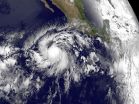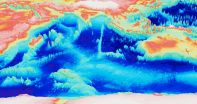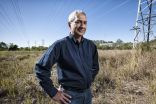(Press-News.org) CAMBRIDGE, Mass--After years of research decoding the complex structure and production of spider silk, researchers have now succeeded in producing samples of this exceptionally strong and resilient material in the laboratory. The new development could lead to a variety of biomedical materials -- from sutures to scaffolding for organ replacements -- made from synthesized silk with properties specifically tuned for their intended uses.
The findings are published this week in the journal Nature Communications by MIT professor of civil and environmental engineering (CEE) Markus Buehler, postdocs Shangchao Lin and Seunghwa Ryu, and others at MIT, Tufts University, Boston University, and in Germany, Italy, and the U.K.
The research, which involved a combination of simulations and experiments, paves the way for "creating new fibers with improved characteristics" beyond those of natural silk, says Buehler, who is also the department head in CEE. The work, he says, should make it possible to design fibers with specific characteristics of strength, elasticity, and toughness.
The new synthetic fibers' proteins -- the basic building blocks of the material -- were created by genetically modifying bacteria to make the proteins normally produced by spiders. These proteins were then extruded through microfluidic channels designed to mimic the effect of an organ, called a spinneret, that spiders use to produce natural silk fibers.
No spiders needed
While spider silk has long been recognized as among the strongest known materials, spiders cannot practically be bred to produce harvestable fibers -- so this new approach to producing a synthetic, yet spider-like, silk could make such strong and flexible fibers available for biomedical applications. By their nature, spider silks are fully biocompatible and can be used in the body without risk of adverse reactions; they are ultimately simply absorbed by the body.
The researchers' "spinning" process, in which the constituent proteins dissolved in water are extruded through a tiny opening at a controlled rate, causes the molecules to line up in a way that produces strong fibers. The molecules themselves are a mixture of hydrophobic and hydrophilic compounds, blended so as to naturally align to form fibers much stronger than their constituent parts. "When you spin it, you create very strong bonds in one direction," Buehler says.
The team found that getting the blend of proteins right was crucial. "We found out that when there was a high proportion of hydrophobic proteins, it would not spin any fibers, it would just make an ugly mass," says Ryu, who worked on the project as a postdoc at MIT and is now an assistant professor at the Korea Advanced Institute of Science and Technology. "We had to find the right mix" in order to produce strong fibers, he says.
Closing the loop
This project represents the first use of simulations to understand silk production at the molecular level. "Simulation is critical," Buehler explains: Actually synthesizing a protein can take several months; if that protein doesn't turn out to have exactly the right properties, the process would have to start all over.
Using simulations makes it possible to "scan through a large range of proteins until we see changes in the fiber stiffness," and then home in on those compounds, says Lin, who worked on the project as a postdoc at MIT and is now an assistant professor at Florida State University.
Controlling the properties directly could ultimately make it possible to create fibers that are even stronger than natural ones, because engineers can choose characteristics for a particular use. For example, while spiders may need elasticity so their webs can capture insects without breaking, those designing fibers for use as surgical sutures would need more strength and less stretchiness. "Silk doesn't give us that choice," Buehler says.
The processing of the material can be done at room temperature using water-based solutions, so scaling up manufacturing should be relatively easy, team members say. So far, the fibers they have made in the lab are not as strong as natural spider silk, but now that the basic process has been established, it should be possible to fine-tune the materials and improve its strength, they say.
"Our goal is to improve the strength, elasticity, and toughness of artificially spun fibers by borrowing bright ideas from nature," Lin says. This study could inspire the development of new synthetic fibers -- or any materials requiring enhanced properties, such as in electrical and thermal transport, in a certain direction.
INFORMATION:
The research was supported by the National Institutes of Health, the National Science Foundation, the Office of Naval Research, the National Research Foundation of Korea, and the European Research Council.
Lugano, 28 May 2015. The European Society for Medical Oncology (ESMO), in collaboration with the European Organisation for Research and Treatment of Cancer (EORTC), expressed their views on the EU Clinical Trials Regulation in an official position paper recently published in Annals of Oncology1.
"The Clinical Trials Regulation (CTR) represents one of the most important changes in the field of clinical trials in the last decade, however it still contains unresolved issues that may prove to be challenging for research in Europe and for implementation by Member States," ...
NEW YORK (May 28, 2015) - Healthcare workers frequently contaminate their gloves and gowns during every day care of nursing homes residents with drug resistant Staphylococcus aureus or MRSA, according to a new study. The findings were published online today in Infection Control & Hospital Epidemiology, the journal of the Society for Healthcare Epidemiology of America.
"One in four nursing home residents harbor MRSA in some settings. We know that healthcare workers serve as a vector for MRSA transmission from one resident to another in settings such as nursing homes," ...
May 28, 2015 Toronto - A landmark clinical study in the Lancet provides convincing evidence that a frequently overlooked therapy for genetically-caused emphysema is effective and slows the progression of lung disease.
Alpha-1 antitrypsin deficiency is an inherited disorder that can cause emphysema even without exposure to tobacco smoke. Alpha-1 antitrypsin (AAT) is a protein made in the liver that protects the lungs. With this disorder, the AAT protein builds up in liver cells and doesn't reach the lungs to protect them. Augmentation therapy involves regular infusions ...
New research by conservationists at the University of Kent suggests that in order to manage trade-threatened species more effectively the Convention on International Trade in Endangered Species of Wild Fauna and Flora (CITES) needs to act more upon the economic reality of wildlife trade.
In a paper published in Biological Conservation Dan Challender and colleagues, Professor Douglas MacMillan from Kent and Professor Stuart Harrop from the University of Sussex, critically and constructively evaluated the CITES approach to controlling trade through means of a case study ...
The first tropical depression of the Eastern Pacific hurricane season formed during the early morning of Thursday, May 28, 2015, well southwest of Mexico. An image of the storm taken from NOAA's GOES-West satellite shows the depression in infrared light as it was born in the early morning hours before sunrise. To the east of the depression, the GOES image shows the sunlight of dawn reaching Mexico's Yucatan Peninsula.
At 0900 UTC (5 a.m. EDT) the center of Tropical Depression One-E was located near latitude 11.0 North, longitude 110.4 West, ABOUT 685 miles (1,105 km) ...
Lip reading normally involves deciphering speech patterns, movements, gestures and expressions just by watching a person speak. Planet Earth has LIPS, too - they are an acronym for Large Igneous Provinces, huge accumulations of igneous rocks that form when hot magma extrudes from inside the Earth and flows onto the surface of the seafloor under several kilometres of water.
An international team of scientists including University of Sydney geophysicists Professor Dietmar Müller, Dr Simon Williams and Dr Maria Seton from the School of Geosciences have found a novel ...
Despite community concerns about living under high-voltage power lines, a world-first QUT study reveals that there are far more charged particles beside busy roads.
The study, published in the international journal Science of the Total Environment was conducted by Dr Rohan Jayaratne, Dr Xuan Ling and Professor Lidia Morawska from QUT's International Laboratory for Air Quality and Health who found that within 10 metres of a freeway, charged particles were up to 15 times more concentrated than beneath high-voltage power lines.
"Although the effects of ions and charged ...
ESF has just published a report on a pilot study of the career paths of post-doctorates and doctorate alumni from five research funding and research performing organisations: AXA Research Fund (AXA RF), France, Fonds National de la Recherche (FNR), Luxembourg, Goethe Graduate Academy at the Goethe University Frankfurt (GRADE), Paul Scherrer Institute (PSI), Switzerland and TDR, the Special Programme for Research and Training in Tropical Diseases, a co-sponsored programme of UNICEF, UNDP, the World Bank and WHO.
The study comprised focus groups and a survey of 880 doctorate ...
Earthquakes kill, but their aftershocks can cause the rapid collapse of buildings left standing in the aftermath of the initial quake. Research published in the International Journal of Reliability and Safety offers a new approach to predicting which buildings might be most susceptible to potentially devastating collapse due to the ground-shaking aftershock tremors.
Negar Nazari and John W. van de Lindt of the Department of Civil and Environmental Engineering, at Colorado State University in Fort Collins and Yue Li of Michigan Technological University, in Houghton, USA, ...
In the most extensive survey of its kind ever conducted, a team of scientists have found an unambiguous link between the presence of supermassive black holes that power high-speed, radio-signal-emitting jets and the merger history of their host galaxies. Almost all of the galaxies hosting these jets were found to be merging with another galaxy, or to have done so recently. The results lend significant weight to the case for jets being the result of merging black holes and will be presented in the Astrophysical Journal.
A team of astronomers using the NASA/ESA Hubble Space ...



